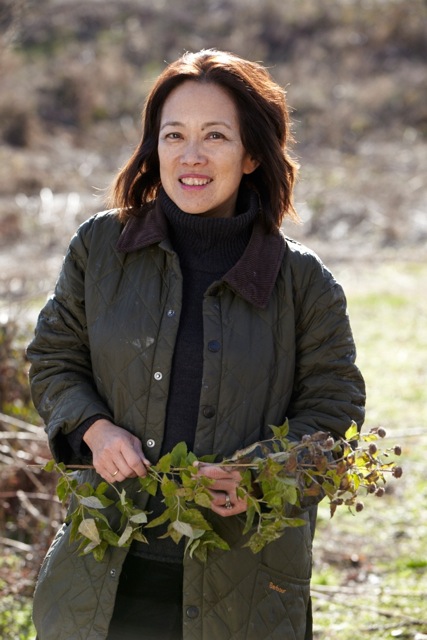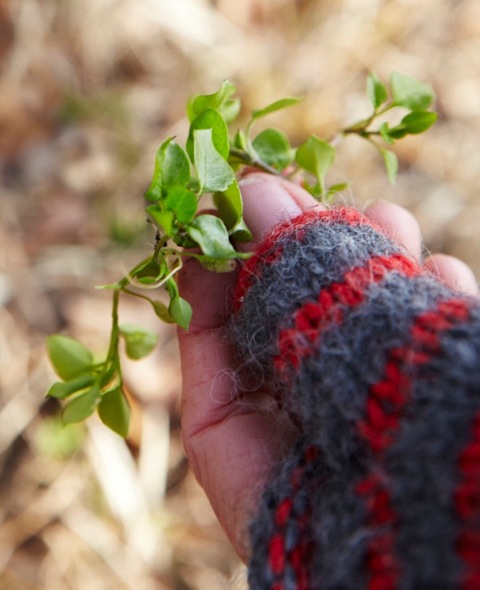
An Interview with Food Forager Tama Matsuoka Wong
If you ever see a petite, dark-haired woman dwarfed by two oversized black garbage bags in Midtown Manhattan, you may have spotted Tama Matsuoka Wong on her way to deliver wild plants like bee balm, Japanese barberry, and cardamine to chefs at some of the city’s best restaurants. Wong, a corporate lawyer-turned-forager and author of the James Beard Award-nominated cookbook Foraged Flavor, is a dynamic personality, bursting with ideas and questions, her words tumbling over each other as she talks. We met for lunch to discuss foraging, and I felt inspired listening to her eagerly, earnestly describe her work. —Stephanie Palumbo
TAMA MATSUOKA WONG: I grew up in New Jersey, but I moved to Hong Kong for twelve years. When I came back, I was like, wow, I have more land now than anybody had in Hong Kong. I wanted a vegetable garden, but I consider myself a black thumb gardener. So I just looked at what was there already, in my backyard.
THE BELIEVER: Did you know anything about plants at that point?
TMW: I started little by little—I’d see something and look it up. In the beginning, I think I knew what an oak tree was. But I got sucked in. It’s one of those things… The more you get into it, the more it gives back to you.
BLVR: I know that you’re working with Gramercy Tavern and a number of other highly-regarded restaurants now, but you began at Daniel Boulud’s restaurant Daniel. How did you begin working with them?
TMW: It was very random. In 2009, I had friends invite me to the restaurant for dinner, and they pushed me to bring stuff in. Eddy [Leroux, Chef de Cuisine] answered us in the kitchen, and he made this amazing dish out of what I brought him. Then we went back to the kitchen, and he was curious, asking me what else I had in my little meadow. I said I had lots of things, and he was like, “Bring me everything.”
BLVR: Did you really bring him everything you had?
TMW: I had to warn him, I’m really passionate about this, so if you tell me to, I’m going to. I’d never bring him anything I hadn’t identified somewhat—I knew what it was, down to the species, and that it had been edible somewhere in human history. My part was to find him what was edible, and his job was to make it delicious.
BLVR: How can someone tell if a plant is inedible or poisonous?
TMW: I wouldn’t recommend that people start with mushrooms, because they can be seriously poisonous. We have very specific lists of the easiest and most accessible plants on our website. There are certain plants like mint or onion grass that you can identify by smell. And if you rip it off and eat a blade of grass instead, you’re not going to die from it or anything.
But there has to be a balance between being afraid to touch anything and trying things just because they’re there. It’s funny—I have a good friend who was inspired to forage, but she has this huge fear of poisonous plants. I was on the phone with her, trying to tell her how nutritious weeds are, and she was like, “Hold on, I’m getting something at Dunkin’ Donuts.” So I thought, how can you worry about what’s poisonous if you’re eating there? Have you seen their ingredient lists? And yet you’re afraid of the stuff that people have been eating for centuries.
BLVR: What’s a good place to start for a first-time forager?
TMW: A lot of so-called “weeds” that we see next to our houses are the easiest to find because they like to be around people. Dandelions, chickweed—they’re opportunist plants. Their seeds are already in the soil, so basically, they wait until the soil is disturbed by humans, and then they grow.
BLVR: In a way, that interaction creates a kind of dialogue between humans and plants.
TMW: That’s why I feel really passionate. We decided that we don’t want those plants. I don’t know why we decided that, but we did. So we spend all this money and time trying to get rid of weeds and put something else there.
BLVR: No one wants these weeds, but you see their value. There’s something beautiful about reclaiming them after they’ve been rejected.
TMW: Yes! I just read this op-ed in the Times about how the suburbs are becoming quite depressed. They’re saying people can no longer maintain their pristine lawns, and they’re choked with weeds, and I’m like, “Yes! That’s good. You can eat!” Why are people buying scallions in the market? Onion grass has an amazing flavor profile and is right in your backyard.
BLVR: And it’s free!
TMW: And it’s healthy, because you’re outdoors, getting sunshine, breathing in fresh air. I read that spending time in nature reboots your mind—you become more creative. The little time we have outside of work is so goal-oriented for people. “I ran a mile, and my heartbeat went to this,” or “I only ate so many calories today.” I think that makes people unhappy because it’s unnatural. Foraging unwinds all the goals we drive ourselves crazy trying to achieve. You’re doing less weeding, mulching, spraying, mowing. You don’t have to do—you just have to undo. It’s so easy.
To me, we’ve been going after all the wrong things, the things that make you happy for five seconds, and then, you know, you want the next one. I can’t get into all this tidiness—my yard has to look like this, my house has to look like this, my body has to look like this. Let’s change the way we think of what’s beautiful. We’ve gotten everything turned upside down. The things people think are oddball are actually the things that are more real and fundamental to how people lived since the beginning.
BLVR: I know you’ve brought your daughters foraging with you. Has that experience made you closer?
TMW: Asking my daughter about her day doesn’t work if she doesn’t want to tell me. But when we’re foraging and sharing in an unstructured way, conversations come out. Even after a stressful day, we come back jolly. Foraging is mucking about.
BLVR: So if you’re feeling down, foraging picks you up?
TMW: It’s rejuvenating to catch these little, fleeting moments. My father was born in Japan, and the Japanese appreciate the beauty in the ephemeral. When I go foraging with my daughters, something will happen and we can’t capture it, but we know it was amazing. Like walking through a meadow in June and the fireflies are a curtain of lights.
BLVR: That sounds magical.
TMW Another time, Eddy was bugging me for daisies, so he could pickle the bud into a kind of caper. I went out with my youngest daughter, Mia, even though all the daisies were finished. We kept looking and couldn’t find any, but then Mia and I walked out onto this field, and it was like we were in a movie—we discovered ten acres of beautiful, delicate daisies, all yellow, white, and green. We were out there clipping them, and I knew it would be a moment that Mia would always remember we shared.
BLVR: What about the rest of your family?
TMW: A couple years ago, I had to move my parents into assisted living, and during that period, I just didn’t do anything else. But then I noticed that my weeds were doing fine.
BLVR: It’s a relief to have something that takes care of itself.
TMW: And it exuberantly takes care of itself. Once you get into it, it’s so easy—you don’t have to do anything. You can just walk around every week and see what’s happening. In a small patch, you can have fifty plants. And they will change every two weeks. You could never plant a garden that did that. You could never replicate the beauty and the complexity of wild gardens.

Photography by Colin Clark
Stephanie Palumbo is a documentary film and television producer, and a former assistant editor at O, the Oprah Magazine. She lives in Brooklyn with her boyfriend and cat. You can follow her @onetoughnun.




